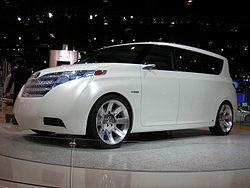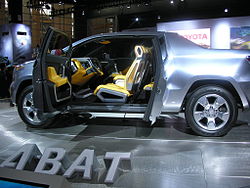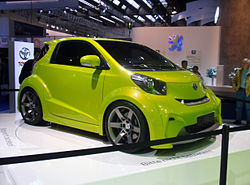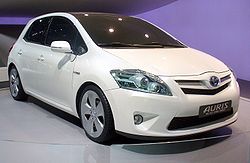- Toyota concept vehicles, 2000-2009
-
ES3
Toyota ES3 Manufacturer Toyota Production 2001 Engine 1.4 L 1ND-TV turbo diesel hybrid The Toyota ES3 (Eco Spirit cubed) was a concept car made by Toyota in 2001.[1][2][3] It was designed to use parts made from bioplastics. The ES3 was not made into a production vehicle but the technology was used in the Raum in 2003 under the name of Toyota Eco-Plastic.
Pod
Toyota Pod 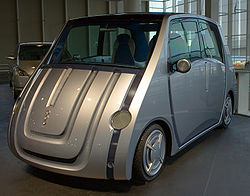
Manufacturer Toyota Production 2001 The Toyota Pod was a concept car created by Toyota in collaboration with Sony.[4][5] The Pod was first shown at the October 2001 Tokyo Motor Show. The Pod was unique as it was designed with artificial intelligence systems built in to make the car appear more personal.
The Pod was much like a living being due to the artificial intelligence programmed into it. The featured a screen inside with Sony-created software running on it, capable of creating shopping lists and running music and radio. The car could also judge the attitude and mood of the driver based on their reactions and how they are driving, and could offer advice on how to improve their current mood. The seats inside are like stools which could freely spin and rotate. On the exterior, the Pod could express its own feelings with coloured LEDs - red for anger, yellow for happy, blue for sad - and an antenna that wags, much like a dog's tail. The Pod was designed as a "car of the future" and hence was never put into production.
The Pod was featured in the game Gran Turismo Concept and had an exclusive race to itself. A new track - using segments from the Clubman Stage Route 5 course - was created which involved 6 Pods driving through the pitlane backwards before stopping in a special area for several seconds before being allowed to resume racing.
DMT
Toyota DMT Manufacturer Toyota Production 2001 Body style Minivan Platform Previa Engine 2.4 L 2AZ-FE I4 The Toyota DMT (Dual Mode Traveller) was a concept van made by Toyota and first shown at the October 2001 Tokyo Motor Show.[6] The van had a high mounted driving position and a rear cabin designed to be useful as an office or studio.
FXS
Toyota FXS Manufacturer Toyota Production 2001 Engine 4.3 L 3UZ-FE V8 Transmission 6-speed manual The Toyota FXS (Future eXperimental Sports) was a concept car made by Toyota and first shown at the October 2001 Tokyo Motor Show.[6] The coupe was powered by a 4.3 L 3UZ-FE V8 engine using a 6 speed sequential manual gearbox.[7]
RSC
Toyota RSC 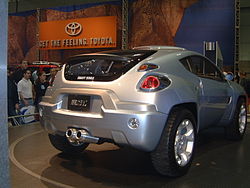
Manufacturer Toyota Production 2001 Body style 2-door SUV Layout 4WD Platform RAV4 Wheelbase 2,490 mm (98 in) Length 4,115 mm (162 in) Width 1,850 mm (73 in) Height 1,550 mm (61 in) The Toyota RSC ("Rugged Sport Coupe") was a Toyota 2-door SUV concept car that was first shown at the February 2001 Chicago Auto Show.[8][9][10]
The RSC was designed by Calty as a 'pure concept vehicle', with no intention to go into production but to 'connect emotionally with young buyers'.[8] Design cues came from rally cars used in the World Rally Championships,[10] with functional lines, a lack of luxury features and 'designed to convey the sparse, functional simplicity of a race car'.[8] The RSC was based on the RAV4.[9]
The RSC was never made into a production vehicle.
RSC at the 2002 LA Auto ShowFCHV-3
Toyota FCHV-3 Manufacturer Toyota Production 2002 Predecessor Toyota FCHV-2 Successor Toyota FCHV-4 Body style SUV Engine Hydrogen fuel cell The FCHV-3 (Fuel Cell Hybrid Vehicle 3) was the third vehicle built by Toyota in it's Fuel Cell Vehicle program. In March 2001, it was presented at the International Symposium on Fuel-Cell Vehicles in Tokyo. Like the FCHV-1 and FCHV-2, it was based on the Highlander.[citation needed]
FCHV-4
Toyota FCHV-4 Manufacturer Toyota Production 2002 Predecessor Toyota FCHV-3 Successor Toyota FCHV-adv Body style SUV Engine Hydrogen fuel cell The FCHV-4 (Fuel Cell Hybrid Vehicle 4) was the fourth vehicle built by Toyota in it's Fuel Cell Vehicle program. Through leasing programs in the USA and Japan, it was the first to be commercialised. Like the FCHV-1, FCHV-2 and FCHV-3, it was based on the Highlander.[citation needed]
MR2 Street Affair
Toyota MR2 Street Affair Manufacturer Toyota Production 2002 Platform MR2 The Toyota MR2 Street Affair was a Toyota concept sports car based on the MR2 that was designed by Toyota Germany.[11][12]
A turbocharger was added to the engine to lift power from 100 kW to 193 kW. The body was made from fibreglass, with carbon fibre panels and numerous air scoops leading to the engine bay. The front took style cues from Toyota's Formula 1 car, having a pointed nose and a front wing close to the ground with Formula 1 style wing-lets in front of semi-exposed tyres. The rear mirror was replaced with a camera.
CS&S
Toyota CS&S 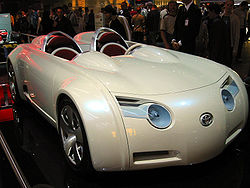
Manufacturer Toyota Production 2003 Body style 2+2 roadster Layout M4 Engine 1.5 L 1NZ-FXE I4 + electic motor Transmission fixed ratio The Toyota CS&S is a four-wheel drive, mid-engine sports car concept made by Toyota and displayed in 2003. It utilizes a hybrid system combining electric motors to drive the front wheels, and a combination of a petrol engine and electric motors powering the rear. It is the first Toyota vehicle to have the feature Toyota Space Touch, a system in which the driver "touches" holographic projections to control other systems (e.g. air conditioning) inside the car.
PM
Toyota PM 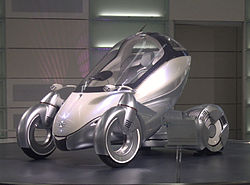
Manufacturer Toyota Production 2003 The Toyota PM is a single seat concept vehicle built by Toyota around the idea of personal mobility. Multiple vehicles can communicate with each other to encourage "meeting, linking and hanging out together".[13][14] It was shown at the October 2003 Tokyo Motor Show.[15]
NLSV
Toyota NLSV Manufacturer Toyota Production 2003 Body style 3-door van The Toyota NLSV is a concept vehicle built by Toyota and first shown at the October 2003 Tokyo Motor Show. It had a high roof, a low, flat floor and the door slid back on rails so that even disabled passengers could enter. The front passenger seat could be folded up and slid forward under the dash to make even more room for wheel chairs or cargo. [16] [17]
X Runner
Not to be confused with Toyota Tacoma X-Runner.Toyota X Runner Manufacturer Toyota Australia Production 2003 Assembly Altona, Victoria Body style Coupé utility Layout 4WD Platform Toyota modular platform Engine 1MZ-FE Wheelbase 2,870 mm (113 in) Length 4,905 mm (193 in) Width 1,910 mm (75 in) Height 1,520 mm (60 in) Curb weight 1,710 kg (3,770 lb) The Toyota X Runner is a four-wheel drive coupé utility concept vehicle designed and built by Toyota Australia in 2003.[18][19]
The X-Runner was based on the Avalon, using the Avalon's front cabin, front sheet metal (except the grill) and mechanicals. The Avalon's chassis (the Toyota modular platform, also shared with the Camry) was stretched by 150mm just before the rear wheels. The 1MZ-FE engine was upgraded with a TRD supercharger and transmission is by a version of the viscous coupled four wheel drive system used in the Lexus RX300.
The front suspension kept the McPherson struts from the Avalon with upgraded brakes and 19" wheels. The rear suspension was modified from the Tarago 4WD.
Fine-N
Toyota Rugged Youth Utility Manufacturer Toyota Production 2003 Successor FJ Cruiser The Rugged Youth Utility was a 4WD concept vehicle that was first shown at the January 2004 North American International Auto Show. It had styling cues reminiscent of the FJ40 Landcruiser but based on the modern Land Cruiser Prado platform. [20] It was not meant meant to be a production vehicle but demand was high enough that it was put into production in early 2006 as the FJ Cruiser.
Fine-S
Toyota Fine-S Manufacturer Toyota Production 2003 Successor Fine-N Engine hydrogen fuel cell electric hybrid Wheelbase 3,100 mm Length 4,355 mm Width 1,820 mm Height 1,495 mm The Fine-S (Fuel cell INnovative Emotion-Sport) was a concept vehicle that was shown at the January 2003 North American International Auto Show and the March 2003 Geneva Motor Show. [21] [22] [23] [24] The Fine-S uses a hydrogen fuel cell electric hybrid system which drives four independent electric motors - one in each wheel. [25]
Fine-N
Toyota Fine-N 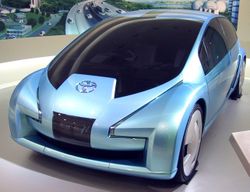
Manufacturer Toyota Production 2003 Predecessor Fine-S Successor Fine-X Engine hydrogen fuel cell electric hybrid Wheelbase 3,100 mm Length 4,355 mm Width 1,820 mm Height 1,495 mm The Fine-N was a concept vehicle that was an update to the Fine-S and was shown at the October 2003 Tokyo Motor Show and the January 2004 North American International Auto Show.
The Fine-N uses a hydrogen fuel cell electric hybrid system which drives four independent 25 kW electric motors - one in each wheel. The hybrid system uses a Lithium-ion battery under the seats. Control is by drive-by-wire. [26] [27] [28]
FrontSideAlessandro Volta
Toyota Alessandro Volta 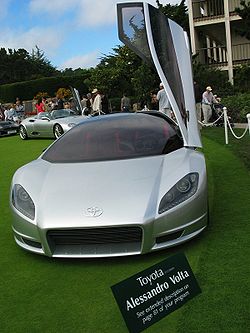
Manufacturer Toyota Production 2004 Layout MR layout Engine 3.3 L 3MZ-FE V6 hybrid electric The Alessandro Volta is a concept car developed in the collaboration of the Japanese manufacturer Toyota and the Italian design company Italdesign Giugiaro. [29] [30] The concept vehicle named after Alessandro Volta, the Italian physicist who invented the battery (and the namesake of the volt unit of measurement), was officially unveiled at the 2004 Geneva Motor Show as a study of a hybrid electric sports car.
The concept never materialised as a production car due to high costs involved.
The car was built on a carbon fibre chassis and seats three people abreast.
It features a four wheel drive hybrid electric power-train of the Lexus RX 400h which combines a 3.3 L V6 3MZ-FE petrol engine with two electric motors. The petrol engine is fitted behind the rear axle and there are additional two electrically powered engines, one on each axle. The combination develops a maximum output of 300 kW (402 bhp), which enables the car to accelerate from 0 to 100 km/h (0 to 62 mph) in 4.03 seconds and reach the top speed of 250 km/h (155 mph). It uses drive-by-wire controls.
Motor Triathlon Race Car
Toyota Motor Triathlon Race Car 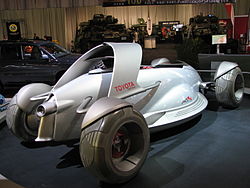
Manufacturer Toyota Production 2004 Layout 4WD with wheel hub motors Wheelbase 2,950 mm (116.1 in) Length 4,060 mm (159.8 in) Width 1,930 mm (76.0 in) Height 1,330–1,480 mm (52.4–58.3 in) The Motor Triathlon Race Car (MTRC) is a two-seater fuel cell concept vehicle designed and built by the Toyota European Design and Development studio. It made its world premier at the March 2004 Geneva Motor Show, and its US debut at the April 2004 New York International Auto Show. [31] [32] [33]
The MTRC is a response to the cultural interests of young people today, such as mobile phones, video games, computers and internet play.[32]
Power is provided by Toyota's hydrogen fuel cells. These provides electricity to four wheel hub motors. Each wheel also features electronically controlled suspension and sensors, allowing each wheel to maximise grip and to use the correct amount of torque for the current road conditions. The open cockpit requires the driver to wear a helmet - which has an internal head-up display.[33]
The MTRC is available in the videogame Gran Turismo 4. As it is a concept car, it cannot be purchased but must be won.[33]
MTRC at the 2004 Geneva Motor Show.MTRC at the 2007 Canadian International AutoShowFTX
Toyota FTX Manufacturer Toyota Production 2004 Successor second-generation Tundra Body style Pickup truck Related Tundra The FTX is a concept full-size pickup truck that Toyota showed to the public at the January 2004 North American International Auto Show.[34] The redesigned 2007 model year Tundra was based on the FTX concept vehicle.
Fine-X, Fine-T
Toyota Fine-X, Fine-T 
Manufacturer Toyota Production 2005 Predecessor Fine-N Length 3,860 mm Width 1,750 mm Height 1,550 mm The Fine-X (Fuel cell INnovation Emotion-eXperiment) was a concept vehicle that was shown at the October 2005 Tokyo Motor Show and the March 2006 Geneva Auto Show. [35] [36] [37] In Japan and Europe it was called the Fine-T. [21] [35]
The Fine-X uses a fuel cell hybrid system which drives four independent motors - one in each wheel. It can make perfect U-turns and park very easily, thanks to its independent four-wheel steering. The Fine-X uses the latest IT/ITS peripheral-monitoring technology that allows the Fine-X to have much smoother driving.
The Fine-X uses gull-wing doors, which are said to make it easier to get in and out of the car. The powered seats can rotate and shift sideways through the gull-wing door openings.
Fine-X showing four-wheel steeringFSC
Toyota FSC 
Manufacturer Toyota Production 2005 Successor Toyota Mark X ZiO Platform Camry Length 4670 mm Related Camry The FSC (Flexible Saloon Concept) was a concept wagon based on the Camry that was first shown at the October 2005 Tokyo Motor Show.[38][39] The first two rows had two bucket seats each. The third row bench seat could be set to hold two more passengers. The rear seat backrest could also be folded down to make a long deck at lower cushion height. Lastly, the rear seat backrest could be left upright and the lower cushions could be electrically retracted into the cargo area to make a deep cargo space.
The FSC was made into production in Japan only as the Mark X ZiO.[40][41][42]
Camry TS-01
Main article: Toyota Camry TS-01Toyota Camry TS-01 
Manufacturer Toyota Australia Production 2005 Class Mid-size Body style 4-door sedan Layout FF Engine 3.0 L 1MZ-FE V6 supercharged Transmission 5-speed manual Related Camry Designer Toyota Style Australia The Camry TS-01 is a concept car based on the Camry and was unveiled at the March 2005 Melbourne International Motor Show in Australia. The aim of the Camry TS-01 was to showcase the skill of Toyota Australia designers and engineers.
Its major features are the stylist changes and the supercharged 1MZ-FE engine.
Aurion Sports Concept
Toyota Aurion Sports Concept 
Manufacturer Toyota Australia Production 2006 Predecessor Toyota Camry TS-01 Successor TRD Aurion Class Mid-size Body style 4-door sedan Layout FF Engine 3.0 L 1MZ-FE V6 supercharged Related Aurion, TRD Aurion, Camry Designer Toyota Style Australia Main article: TRD AurionThe Aurion Sports Concept was a concept car based on the Aurion (which was itself based on the Camry) and revealed at the October 2006 Australian International Motor Show.[43] The car was a styling exercise previewing the TRD Aurion, which was subsequently released in August 2007.[44]
F3R
Toyota F3R Manufacturer Toyota Production 2006 Engine Hybrid The Toyota F3R was a concept car by Toyota's Calty design facility that was introduced at the January 2006 North American International Auto Show.[45][46] It is a hybrid powered minivan designed to have youthful appeal and escape the "soccer mom" stigma commonly associated with minivans.
The F3R has three rows of seats with three doors on either side. The front and middle doors open normally but the rear door opens in the opposite direction. There is no pillar between the middle and rear doors, so the openings are very large. The right and centre seats in middle row fold flat into the floor and the remaining left hand seat can be fully reclined to make a sideways-facing bench seat.
Exterior styling is similar to the Scion xB with 22 inch wheels.
Hybrid X
Toyota Hybrid X 
Manufacturer Toyota Production 2007 Body style 4-door sedan Wheelbase 2,800 mm (110.2 in) Length 4,500 mm (177.2 in) Width 1,850 mm (72.8 in) Height 1,440 mm (56.7 in) The Toyota Hybrid X is a hybrid concept built by Toyota's ED² studio in France and first shown at the March 2007 Geneva Motor Show. Toyota claims the design of this concept car points to the future direction of the Toyota Prius.[47] [48] [49]
According to interior designer Laurent Bouzige, the Hybrid X is supposed to be a very sensory experience, and the ambiance is linked to the passengers' sight, sound, touch, and smell senses. Interior surfaces have a variety of light effects, textures and even fragrance from a perfume diffuser. The drive-by-wire steering pad has a touch screen and there is another screen in the centre of the dashboard to show vehicle information and set to set minor controls The rear seats can each be turned 12 degrees left or right to help passengers look inwards or outwards.
Hi-CT
Toyota Hi-CT 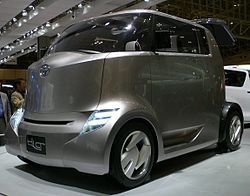
Hi-CT at the 2007 Tokyo Motor ShowManufacturer Toyota Production 2007 Length 3,330 mm Width 1,695 mm Height 1,780 mm The Toyota Hi-CT (Hi ride City Truck)[50] is a 2-seat concept car built by Toyota and first shown at the October 2007 Tokyo Motor Show.[51]
Motive power is by a plug-in hybrid with batteries under the floor. A 100 volt AC socket is provided to power accessories.[52]
The rear seats can be rotated to look backwards through the rear hatch. The boot is a removable module which can be replaced with other modules. If no module is used then the small cargo deck can be used to carry items such as surfboards. The rear hatch can not be opened when the rear deck is in use or if a module is in place.
Hi-CT at the 2007 Tokyo Motor ShowRiN
Toyota RiN 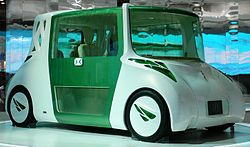
Manufacturer Toyota Production 2007 The Toyota RiN is a concept car built by Toyota and first shown at the October 2007 Tokyo Motor Show. The vehicle was designed to promote relaxation and healthiness. It has received much media attention for its odd design and its steering wheel, which changes colour depending on the driver's mood. The concept was unveiled at the October 2007 Tokyo Motor Show.[53][54][55][56]
The concept features four seats accessed by two large sliding doors, and windows made of green glass, designed to reduce ultraviolet and infra-red light. "The concept, which looks like some sort of futuristic stagecoach, is designed to help its driver become one with nature".[56] The car features a pinpoint humidifier, and an oxygen-level conditioner. It was reported that the car was inspired by a milkfloat.
A Toyota press release stated that "the RiN focuses on increased comfort and serene, healthy living. Through their relationship to the vehicle, drivers are encouraged to reevaluate themselves and, furthermore, to turn their attention to society and nature, producing a healthy rhythm for both mind and body." Toyota says the car "creates a feeling of harmony with the surrounding environment by using sliding doors with a low window that lets you view nature at ground level, as well as headlights with light distribution control that take into consideration pedestrians and vehicles coming in the opposite direction."[57]
Toyota RiN at the 2007 Tokyo Motor Show1/X
Toyota 1/X 
Manufacturer Toyota Production 2007 Engine 500cc with electric motor The Toyota 1/X (pronounced one-Xth) is a concept car built by Toyota and first shown at the October 2007 Tokyo Motor Show. It is a petrol-electric hybrid vehicle utilizing plug-in technology. The car weighs only 926 pounds (420 kg) but has as much interior room as the Toyota Prius. [58] The car's frame is mainly carbon-fiber reinforced plastic, which allows it to be light weight yet strong. The engine is 500 cc and sits under the rear two of four seats, driving the rear wheels. [59]
Toyota envisions the car to be made of seaweed in the future. [60]
FT-HS
Toyota FT-HS 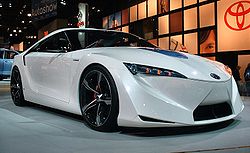
Manufacturer Toyota Production 2007 Predecessor Toyota Supra Body style 2+2 coupe Layout Front-engine, RWD Engine 3.5 L V6 hybrid electric Wheelbase 104.33 in (2,650 mm) Length 170.27 in (4,325 mm) Width 73.23 in (1,860 mm) Height 50.79 in (1,290 mm) Main article: Toyota FT-HSThe Toyota FT-HS is a hybrid sports car concept introduced at the January 2007 North American International Auto Show. Calty Design Research designed the concept and suggests that it could fill the place of the Toyota Supra.[61] FT-HS stands for Future Toyota Hybrid Sport.[62]
A-BAT
Toyota A-BAT Manufacturer Toyota Production 2007 Length 181.3 in (4,605 mm) Designer Calty The A-BAT is a concept truck revealed on 27 December 2007 and manufactured by Toyota. [63] [64] The A-BAT is the first Toyota to have a mid-gate allowing cargo longer than the standard four-foot bed to extend into the cab (like a Chevrolet Avalanche or Honda Ridgeline). Power for the A-BAT comes from Toyota's Hybrid Synergy Drive mated to a four-cylinder engine. The A-BAT officially debuted at the January 2008 North American International Auto Show in Detroit.
The concept truck is similar in size to Toyota's compact SUV, the RAV4. The A-BAT measures 181.3 inches in length, [65] while the RAV4 measures 181.1 inches. [66] It can also seat up to four people.
On 22 September 2008, the website PickupTrucks.com indicated that Toyota had confirmed that some form of the Toyota A-BAT would see production, barring unforeseen production costs. The article also stated that Toyota had cancelled production of a Tundra diesel truck. Although Toyota later denied official confirmation of the Tundra's cancellation, no mention was made denying the statement regarding the A-BAT. Sources say that a production version of the concept will likely have a four-cylinder engine as an option, as well as a four-cylinder hybrid engine.[67]
FCHV-adv
Main article: Toyota FCHVToyota FCHV-adv 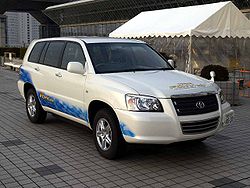
Manufacturer Toyota Production 2008 Predecessor Toyota FCHV-4 Body style SUV Engine 90kW fuel cell-stack Wheelbase 106.9 in (2,715 mm) Length 185.6 in (4,714 mm) Width 71.9 in (1,826 mm) Height 68.9 in (1,750 mm) Curb weight 1,880 kg (4,100 lb) Related Toyota Highlander (XU20)
Lexus RX (XU10)[68]The FCHV-adv (Fuel Cell Hybrid Vehicle advanced) was the fifth vehicle built by Toyota in it's Fuel Cell Vehicle program. It was available through a leasing program in Japan from 11 September 2008.[69] Like the FCHV-1, FCHV-2, FCHV-3 and FCHV-4, it was based on the Highlander.[70]
Aygo Crazy
Main article: Toyota Aygo CrazyToyota Aygo Crazy 
Manufacturer Toyota Production 2008 The Aygo Crazy is a concept vehicle built by Toyota as a modified Toyota Aygo and first revealed at the July 2008 British International Motor Show.
FT-EV
Toyota FT-EV 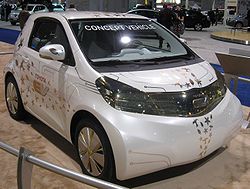
Manufacturer Toyota Production 2009 Successor FT-EV II Platform iQ The Toyota FT-EV is a small, battery electric, concept vehicle built by Toyota as a modified Toyota iQ and demonstrated at the January 2009 North American International Auto Show. Two of the iQ's seats were removed to make room for the battery packs. Toyota plans to start selling the FT-EV in 2012.[71][72] According to Toyota the FT-EV was designed as an urban commuter car with a range of 50 miles (80 km) per charge.[73]
FT-EV II
Toyota FT-EV II 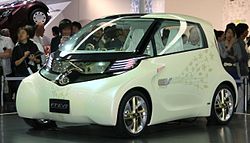
Manufacturer Toyota Production 2009 Predecessor FT-EV Successor EV Prototype Platform iQ Wheelbase 1,900 mm (74.8 in) Length 2,730 mm (107.5 in) Width 1,680 mm (66.1 in) Height 1,490 mm (58.7 in) The Toyota FT-EV II is a small, battery electric, concept vehicle built by Toyota as a modified Toyota iQ and first shown at the October 2009 Tokyo Motor Show.[74] It differs from the FT-EV by seating four people, by having more parts of the body transparent and electrically operated sliding doors. A pair of linked joysticks (each joystick duplicating the other) control acceleration, braking and steering using drive-by-wire.[75] The top speed is over 100 km/h (62 mph) and the range is 90 km (56 mi).
Scion iQ Concept
Scion iQ Concept Manufacturer Toyota Production 2009 Class Microcar Body style 3-door hatchback Layout FF Platform iQ Engine 1.3 L I4 Wheelbase 78.7 in (1,999 mm) Length 126.9 in (3,223 mm) Width 71.4 in (1,814 mm) Height 56.9 in (1,445 mm) The Scion iQ Concept vehicle was built by Five Axis (California, USA) based on the Toyota iQ and displayed in April 2009 at the New York Auto Show.[76] Changes included a 1.3 litre 4-cylinder VVT-i engine, Five Axis custom stainless exhaust, 18x8.5-inch Five:AD S6:F custom wheels with nickel finish prototyped by MetalFX, Yokohama S.drive 2.5/40R18 tires, TEIN Super Street coil over suspension, Five Axis wide body conversion kit, custom accented headlights and tail lights.
An identical car, rebadged as the Toyota iQ Sport, was later presented at the September 2009 Frankfurt Motor Show.
Motor Trend reported the production version of Scion iQ would begin in North America in late 2010 for the 2011 model year, or in early 2011 for the 2012 model year. The air bags will be recalibrated for unbelted and out-of-position occupants and the bumpers will be slightly extended.[77]
Auris HSD Full Hybrid Concept
Toyota Auris HSD Full Hybrid Concept Manufacturer Toyota Production 2009 Main article: Toyota Auris HSD Full Hybrid ConceptThe Toyota Auris HSD Full Hybrid Concept vehicle was a petrol-electric hybrid vehicle based on the Auris and displayed at the September 2009 Frankfurt Motor Show.
RearFT-86 Concept
FT-86 Concept Manufacturer Toyota & Subaru Also called Subaru BRZ Production 2009 Successor FT-86 G Sports Concept Body style Coupé Layout FR Toyota
FR SubaruPlatform shortened Subaru Impreza Engine 2.0 L Toyota-Subaru "D-4S" Flat-4 Transmission 6 speed manual Wheelbase 2,570 mm (101.2 in) Length 4,160 mm (163.8 in) Width 1,760 mm (69.3 in) Height 1,260 mm (49.6 in) The Japanese: Toyota FT-86 Concept is a concept car manufactured jointly by Toyota and Subaru. The vehicle consists of many design cues from the earlier FT-HS concept. All that is known about the car so far is that it will be a light front engine, rear drive, 4 or 5 seat coupé, with a new 2 litre Toyota-Subaru "D-4S" Boxer engine.[78] The FT-86 rides on a modified Subaru Impreza platform with 101.2-inch wheelbase, with length, width, and height measuring 163.8, 69.3, and 49.6 inches, respectively.[79] A base price in the US$20,000 range is expected when the car hits the market with the Subaru version following shortly afterwards.[80]
It is expected that the Toyota and Subaru versions will be styled similarly on the outside, with the Subaru version getting different head and tail lights and a different hood. It has a 2.0 litre naturally aspirated boxer engine mated to a Subaru 6-speed manual transmission.[81] The concept is fitted with brakes from Advics, a joint venture company formed between Aisin Seiki, Denso, Sumitomo Electric and Toyota.
According to chief engineer Tetsuya Tada, the unique shoujyouhi red colour was based on the colour of a Japanese monkey's backside.[82]
The FT-86 Concept was first shown at the October 2009 Tokyo Motor Show[83] and the first showing outside of Japan was at the March 2010 Geneva Motor Show.[84] An enhanced version called the FT-86 G Sports Concept was shown at the January 2010 Tokyo Auto Salon as part of the Toyota G Sports range.
At the Oct 2009 Tokyo Motor Show, Jim Lentz, COO and President of Toyota Motor Sales USA confirmed that the production version of the FT-86 is scheduled to be sold in America but an actual date was not yet disclosed.[85] However, at the March 2010 Geneva Motor Show, Toyota Europe announced that the production version of the vehicle will be released in November 2011.[86]
On 2 September 2010, British car magazine AutoExpress [87] reported the Subaru model will feature an all-wheel drive drivetrain as opposed to the salient feature of rear-wheel drive for the Toyota-badged model. They claimed the Subaru model's all-wheel drive system would have a rear-wheel bias, improving handling. The flat-four, longitudinal engine layout would also be fully coherent with the model policy and mechanical characteristics of all Subaru cars of the past 30 years.
More recent reporting indicates the Subaru version will not have the advantage of turbocharging to give it the power necessary for sporting performance. It may not have all-wheel drive.[88]
Toyota Europe presented the FT-86 II Concept at the March 2011 Geneva Motor Show as the successor to the FT-86 Concept.
Prius Plug-In Hybrid Concept
See also: Toyota Prius Plug-in HybridPrius Plug-In Hybrid Concept 
Manufacturer Toyota Production 2009 Class Midsize car Body style 5-door hatchback Layout FF Platform XW30 Prius Engine 1.8 L 2ZR-FXE I4 & electric motor Transmission 1-speed planetary gear Length 4,460 mm (175.6 in) Width 1,745 mm (68.7 in) Height 1,480 mm (58.3 in) The Prius Plug-In Concept is a plug-in hybrid concept car shown at the October 2009 Tokyo Motor Show based on the third generation Prius and the predecessor of the for-mass-production Toyota Prius Plug-in Hybrid. Its batteries can be charged in 180 minutes from 100 volts or in 100 minutes from 200 volts and can travel 20 km before needing to start the petrol engine.[74][89][90]
See also
- Toyota concept vehicles, 1935-1969
- Toyota concept vehicles, 1970-1979
- Toyota concept vehicles, 1980-1989
- Toyota concept vehicles, 1990-1999
- Toyota concept vehicles, 2010-2019
References
- ^ "Market Debut as Toyota Eco-Plastic". Environmental & Social Report 2003. Toyota. 2003. http://www.toyota.co.jp/en/environmental_rep/03/pdf/E_c48_51.pdf. Retrieved 2010-04-21.
- ^ "2001 Toyota ES3 Concept". supercars.net. 2001. http://www.supercars.net/cars/1802.html. Retrieved 2010-04-21.
- ^ Liz Kim (2006-10-11). "Toyota ES3". Inside Line. Edmunds. http://www.insideline.com/toyota/es3/2001-tokyo-toyota-es3.html. Retrieved 2010-04-21.
- ^ Masatsugu Arimoto (2001-10-20). "Toyota's expressive POD concept for Tokyo Motor Show". cardesignnews. http://www.cardesignnews.com/autoshows/2001/tokyo/preview/toyota-pod. Retrieved 2010-04-20.
- ^ "2002 Toyota POD Images, Information and History". conceptcarz. 2002. http://www.conceptcarz.com/vehicle/z4838/Toyota_POD/default.aspx. Retrieved 2010-04-20.
- ^ a b John Rettie (2001-01-28). "2001 Tokyo Show, Part II". The Car Connection. http://www.thecarconnection.com/autoshows-article/1003197_2001-tokyo-show-part-ii. Retrieved 2010-07-19.
- ^ "Toyota FSX Concept". otoblack. 2010-05-16. http://otoblack.com/2010/05/16/car/toyota-fsx-concept.html. Retrieved 2010-07-19.
- ^ a b c "Toyota Rugged Sport Coupe". ToyotaOffRoad.com. 2001-02-07. http://www.toyotaoffroad.com/Articles/Toyota/RSC/rugged_sport_coupe.htm. Retrieved 2010-04-22.
- ^ a b "First Look: Toyota RSC". Motor Trend (May). 2001. http://www.motortrend.com/future/concept_cars/112_0105_toyota_rsc/index.html.
- ^ a b "Toyota unveils RSC "Rugged Sport Coupe Concept" Chicago". Automotive Intelligence. 2001-02-07. http://www.autointell.com/asian_companies/toyota_motor/toyota-concepts/toyota-rsc/toyota-rsc-01.htm. Retrieved 2010-04-22.
- ^ "Toyota Exhibit: Sydney Motor Show 2002". Web Wombat. 2002. http://www.webwombat.com.au/motoring/news_reports/8_10_toy.htm. Retrieved 2010-08-05.
- ^ "Toyota to Unveil Two Show Stoppers at Brisbane Motor Show". AutoWeb. 2003-01-20. http://www.autoweb.com.au/cms/A_55366/title_Toyota-to-Unveil-Two-Show-Stoppers-at-Brisbane-Motor-Show/newsarticle.html. Retrieved 2010-08-05.
- ^ "PM — the personal mobility vehicle". Toyota USA. http://www.toyota.com/concept-vehicles/pm.html. Retrieved 2010-06-30.
- ^ Kevin Bonsor. "How the Toyota PM Works". how stuff works. http://auto.howstuffworks.com/toyota-pm.htm. Retrieved 2010-11-28.
- ^ "Tokyo Motor Show 2003 - Highlights". cardeisgnnew. http://archive.cardesignnews.com/autoshows/2003/tokyo/highlights/index.html. Retrieved 2010-11-28.
- ^ "Toyota Concept Vehicles -- NLSV". Toyota USA. http://www.toyota.com/concept-vehicles/nlsv.html. Retrieved 2011-07-13.
- ^ Michelle Krebs. "Toyota NLSV". cars.com. http://www.cars.com/go/features/autoshows/vehicle.jsp?autoshow=&vehicletype=concept&autoshowyear=2003&vehicle=concept_toyota_nlsv. Retrieved 2011-07-13.
- ^ Bruce Newton (2003-03-03). "First look: X-Runner is a first for Toyota". GoAuto.com.au. http://www.goauto.com.au/mellor/mellor.nsf/story2/958DF6F29ED78F68CA2572100028B758. Retrieved 2010-11-05.
- ^ Marton Pettendy (2003-03-26). "Exclusive! Why Toyota built X-Runner". GoAuto.com.au. http://www.goauto.com.au/mellor/mellor.nsf/story2/54AC2176B150C864CA2572100028B7A0. Retrieved 2010-11-05.
- ^ "2011 FJ Cruiser Press Kit". Toyota Australia. 2011-03-07. http://www.pressroom.com.au/press_kit_detail.asp?clientID=2&navSectionID=6&categoryID=1000&kitID=299. Retrieved 2011-09-16.
- ^ a b "Concept Car Gallery". Toyota. http://www.toyota-global.com/innovation/concept_cars/concept_car_gallery.html. Retrieved 2011-03-10.
- ^ Simona (November 2005). "2003 Toyota Fine S". TopSpeed. http://www.topspeed.com/cars/toyota/2003-toyota-fine-s-ar913.html. Retrieved 2011-03-10.
- ^ "Toyota Concept Vehicles -- FINE-S". Toyota USA. http://www.toyota.com/concept-vehicles/fines.html. Retrieved 2011-03-10.
- ^ "Toyota Hybrid Synergy Drive Hybrid future". Toyota Australia. http://www.toyota.com.au/hybrid-synergy-drive/hybrid-future. Retrieved 2011-03-10.
- ^ "Press release for North America International Auto Show". Toyota Japan. March 2003. http://www2.toyota.co.jp/en/news/03/0108.html. Retrieved 2011-03-10.
- ^ "Toyota Fine-N Concept 2003". Auto Concept reviews. October 2003. http://www.autoconcept-reviews.com/cars_reviews/toyota/toyota-fine-n/cars_reviews-toyota-fine-n.html. Retrieved 2011-03-09.
- ^ "Toyota Concept Vehicles -- FINE-N". Toyota USA. http://www.toyota.com/concept-vehicles/finen.html. Retrieved 2011-03-09.
- ^ Toyota press release (January 2004). "2004 Detroit Auto Show: Toyota Exhibits FINE-N Concept". The Auto Channel. http://www.theautochannel.com/news/2004/01/04/175726.html. Retrieved 2011-03-09.
- ^ "2004 Toyota Alessandro Volta Concept". RSportsCars.com. http://www.rsportscars.com/eng/cars/toyota_volta.asp. Retrieved 2009-05-28.
- ^ "2004 Toyota Alessandro Volta". Serious Wheels. http://www.seriouswheels.com/cars/top-2004-Toyota-Alessandro-Volta-Concept.htm. Retrieved 2009-05-28.
- ^ "Toyota Motor Triathlon Race Car". Toyota Europe. http://www.toyota-europe.com/innovation/design/concept_cars/mtrc/index.aspx. Retrieved 2011-04-13.
- ^ a b Ron Kiino (April 2004). "Toyota Motor Triathlon Race Car - Auto Shows". Car and Driver. http://www.caranddriver.com/news/car/04q2/toyota_motor_triathlon_race_car-auto_shows. Retrieved 2011-04-13.
- ^ a b c Shane Speck. "How the Toyota MTRC Works". How Stuff Works. Discovery. http://auto.howstuffworks.com/toyota-mtrc.htm. Retrieved 2011-04-13.
- ^ "Toyota FTX concept may be future Tundra pickup". Canadian Driver FTX. 2004-01-05. http://www.canadiandriver.com/news/2004/040105-14.htm. Retrieved 2010-08-16.
- ^ a b "Toyota Fine-T fuel cell hybrid concept 2006". Auto Concept reviews. March 2006. http://www.autoconcept-reviews.com/cars_reviews/toyota/toyota-fine-t/cars_reviews-toyota-fine-t.html. Retrieved 2011-03-10.
- ^ "Toyota to Display Fuel Cell Hybrid and Personal Mobility Concept Vehicles at Tokyo Motor Show". Toyota. October 2005. http://www.toyota.co.jp/en/news/05/1011_1.html. Retrieved 2011-03-09.
- ^ "Tokyo Motor Show 2005 - Highlights". Car Design News. October 2005. http://archive.cardesignnews.com/autoshows/2005/tokyo/highlights/index.php. Retrieved 2011-03-09.
- ^ "Toyota FSC - Auto Shows - 2005 Tokyo Motor Show". Car and Driver. 2005-10. http://www.caranddriver.com/news/car/05q4/toyota_fsc-auto_shows. Retrieved 2010-08-05.
- ^ "Toyota FSC Concept". World Car Fans. 2005-10-25. http://www.worldcarfans.com/205102612502/toyota-fsc-concept#0. Retrieved 2010-08-05.
- ^ Ganz, Andrew (2007-06-29). "Toyota FSC Rumored For Production". Left Lane. http://www.leftlanenews.com/toyota-fsc.html. Retrieved 2010-08-05.
- ^ Nunn, Peter (2007-09-26). "Japan Report: Toyota Debuts Mark X ZiO". NextAutos. http://www.nextautos.com/countriesmarkets/japan/japan-report-toyota-debuts-mark-x-zio. Retrieved 2010-08-05.
- ^ Roth, Dan (2007-09-27). "Japan: Toyota reveals Mark X ZiO". autoblog. http://www.autoblog.com/2007/09/27/japan-toyota-reveals-mark-x-zio/. Retrieved 2010-08-05.
- ^ Torr, Fean (2006-10-27). "2006 Australian International Motor Show: Part I". WebWombat. http://www.webwombat.com.au/motoring/news_reports/australian-motor-show-2006.htm. Retrieved 2007-10-12.
- ^ "TRD Aurion", Wheels magazine: September 2007: 72–82, 2007
- ^ Joe DeMatio (2009-04). "AUTO SHOWS: 2007 Toyota F3R Concept". Automobile. http://www.automobilemag.com/auto_shows/naias_2006/0602_toyota_f3r/. Retrieved 2010-06-21.
- ^ "F3R — style, performance and three rows of comfort". Toyota USA. 2006. http://www.toyota.com/concept-vehicles/f3r.html. Retrieved 2010-06-21.
- ^ "2008 AIMS PRESS KIT". Toyota Australia. October 2008. http://www.pressroom.com.au/press_kit_detail.asp?clientID=2&navSectionID=6&categoryID=1000&kitID=268. Retrieved 2011-07-13.
- ^ "Toyota Hybrid X concept". Left Lane News. 2007-03. http://www.leftlanenews.com/toyota-hybrid-x-concept.html. Retrieved 2010-06-30.
- ^ Sam Abuelsamid (March 2007). "Geneva Motor Show: Toyota Hybrid-X concept". autobloggreen.com. http://green.autoblog.com/2007/03/06/geneva-motor-show-toyota-hybrid-x-concept/. Retrieved 2011-07-13.
- ^ Simona (October 2007). "2008 Toyota Hi-CT - Top Speed". Top Speed. http://www.topspeed.com/cars/toyota/2008-toyota-hi-ct-ar45111.html. Retrieved 2011-03-17.
- ^ Noel McKeegan (October 2007). "Toyota Hi-CT Concept lifestyle vehicle". gizmag. http://www.gizmag.com/go/8190/. Retrieved 2011-03-17.
- ^ "Toyota Hi-CT Concept - Auto Shows - Car and Driver". October 2007. http://www.caranddriver.com/news/car/07q4/toyota_hi-ct_concept-auto_shows. Retrieved 2011-03-17.
- ^ "Toyota news - Tokyo Madness: Toyota RiN and Hi-CT - 2007 - BBC Top Gear". Topgear.com. 2007-10-10. http://www.topgear.com/uk/car-news/toyota-rin-and-hi-ct-concepts. Retrieved 2010-06-29.
- ^ Lavrinc, Damon (2007-10-10). "Tokyo 2007 Preview: Toyota RiN wants you to relax, be healthy — Autoblog". Autoblog.com. http://www.autoblog.com/2007/10/10/tokyo-2007-preview-toyota-rin-wants-you-to-relax-be-healthy/. Retrieved 2010-06-29.
- ^ "Toyota RiN Concept promotes driver well-being". Gizmag.com. 2007-10-22. http://www.gizmag.com/go/8218/. Retrieved 2010-06-29.
- ^ a b "Toyota RiN Concept - Auto Shows". Car and Driver. http://www.caranddriver.com/news/car/07q4/toyota_rin_concept-auto_shows. Retrieved 2010-06-29.
- ^ "Toyota". Toyota. 1990-01-06. http://www.toyota.co.uk/cgi-bin/toyota/bv/frame_start.jsp?id=concepts. Retrieved 2010-06-29.
- ^ 2007 "Tokyo Auto Show Preview: Toyota 1/X". Edmunds.com. http://www.edmunds.com/insideline/do/News/articleId=122972 2007. Retrieved 2009-05-28.[dead link]
- ^ "Tokyo 2007 Preview: Toyota 1/X (pronounced "1/Xth")". Autoblog. Weblogs, Inc.. http://www.autoblog.com/2007/10/10/tokyo-2007-preview-toyota-1-x-pronounced-1-xth/. Retrieved 2009-05-28.
- ^ "Toyota Envisions Future Hybrid Made of Seaweed". motorcities.com. http://www.motorcities.com/vehicle/09BMG542327361.html. Retrieved 2009-05-28.
- ^ "Toyota hasn't had a sports car since the Supra was dropped in 1997. We need some emotional punch in our lineup, a halo product." Kevin Hunter - vice president of Calty Design Research (from this article)
- ^ Toyota FT-HS World Premiere ROADandTRACK.com'.' Retrieved January 3, 2007.
- ^ Abuelsamid, Sam (2007-12-27). "Toyota A-BAT hybrid pickup concept". Autoblog. Weblogs, Inc.. http://www.autoblog.com/2007/12/27/detroit-08-preview-toyota-a-bat-concept-hybrid-pickup/. Retrieved 2007-12-28.
- ^ Wert, Ray (2007-12-27). "Toyota Reveals New Honda Ridgeline, Calls it the A-BAT Concept Hybrid Truck". Jalopnik. Gawker Media. http://jalopnik.com/338248/detroit-auto-show-toyota-reveals-new-honda-ridgeline-calls-it-the-a+bat-concept-hybrid-truck. Retrieved 2007-12-28.
- ^ "Toyota A-BAT Concept revealed after dark". Autoblog. Weblogs, Inc.. 2008-01-13. http://www.autoblog.com/2008/01/13/detroit-2008-toyota-a-bat-concept-revealed-after-dark/. Retrieved 2009-05-26.
- ^ "2008 Toyota RAV4 Styles". Edmunds.com. http://www.edmunds.com/new/2008/toyota/rav4/100920101/specs.html. Retrieved 2009-05-26.
- ^ "A-BAT A Go, Tundra Light-Duty Diesel Shelved". PickupTrucks.com. 2008-09-22. http://www.pickuptrucks.com/html/news/toyota/future/sources-say-toyota-abat-a-go-tundra-diesel-shelved.html. Retrieved 2009-05-28.
- ^ http://www.toyota.com/esq/articles/2010/FCHV_ADV.html
- ^ "Toyota to Begin Leasing Advanced Fuel Cell Hybrid Vehicle". Toyota. 2008-08-29. http://www2.toyota.co.jp/en/news/08/0829.html. Retrieved 2009-10-08.
- ^ http://www.toyota.com/esq/articles/2010/FCHV_ADV.html
- ^ Ohnsman, Alan (2009-01-10). "Toyota to Sell Tiny U.S. ‘Urban Commuter’ Battery Car by 2012". Bloomberg.com. http://www.bloomberg.com/apps/news?pid=newsarchive&sid=aUMqD_U5PZkQ. Retrieved 2009-06-30.
- ^ Hardigree, Matt (2009-01-10). "Toyota FT-EV Concept: An Electric Car For The Tiny Masses - Toyota FT-EV". Jalopnik. http://jalopnik.com/5128469/toyota-ft+ev-concept-an-electric-car-for-the-tiny-masses. Retrieved 2009-06-29.
- ^ Eric Loveday (2011-04-27). "s the Toyota FT-EV's 50-mile range too low?". AutoblogGreen. http://green.autoblog.com/2011/04/27/is-the-toyota-ft-evs-50-mile-range-too-low/. Retrieved 2011-05-07.
- ^ a b "TMC to Display 3 Concepts, F1 Car at Tokyo Motor Show". 2009-10-06. http://www2.toyota.co.jp/en/news/09/10/1006.html. Retrieved 2009-10-13.
- ^ Williams, Martyn (2009-10-21). "Goodbye steering wheel, here comes drive-by-joystick". Network World. http://www.networkworld.com/news/2009/102109-goodbye-steering-wheel-here-comes.html. Retrieved 2009-10-22.
- ^ Abuelsamid, Sam (2009-04-08). "New York 2009: The Scion iQ goes Big Wheels!". Autoblog.com. http://www.autoblog.com/2009/04/08/new-york-2009-the-scion-iq-goes-big-wheels/. Retrieved 2011-01-26.
- ^ Korzeniewski, Jeremy (2009-06-29). "REPORT: Scion iQ headed for America by early 2011 with a few changes". Autoblog.com. http://www.autoblog.com/2009/06/29/report-scion-iq-headed-for-america-by-early-2011-with-a-few-cha/. Retrieved 2011-01-26.
- ^ Paul Tan (2009-10-13). "Toyota FT-86 to feature D-4S Boxer Engine". http://paultan.org/2009/10/09/toyota-ft-86-to-feature-d-4s-boxer-engine/. Retrieved 2009-10-13.
- ^ "Toyota FT-86 Concept and FT-86 G Sports concept technical facts." (in Japan). Tune86. http://www.tune86.com/ft-86-content/toyota-ft-86-concept-and-ft-86-g-sports-concept-technical-facts. Retrieved 2010-07-16.
- ^ Jez Spinks (2009-10-07). "FT-86: Toyota’s sports car revealed". Sydney Morning Herald. http://www.smh.com.au/drive/motor-news/ft86-toyotas-sports-car-revealed-20091007-glsf.html. Retrieved 2009-10-13.
- ^ "TOYOTA exhibits new concepts at the Tokyo Motor Show" (in Japanese). Toyota. 2009-10-06. http://www2.toyota.co.jp/jp/news/09/10/nt09_070.html. Retrieved 2010-07-16.
- ^ Hans Greimel (2009-10-21). "Tokyo auto show: Toyota goes sporty with FT-86". http://www.autoweek.com/article/20091006/TOKYO/910069998#ixzz0TAez5qn4. Retrieved 2010-01-20.
- ^ Brian Alexander (2009-10-06). "Toyota FT-86 Concept to debut at Tokyo Auto Show". Money & Company. The Los Angeles Times. http://latimesblogs.latimes.com/money_co/2009/10/toyota-ft-86-concept-to-debut-at-tokyo-auto-show.html. Retrieved 2009-10-06.
- ^ "FT86 concept at Geneva auto show 2010!" (in Japan). Tune86. http://www.tune86.com/ft-86-forum/1798-ft86-concept-geneva-auto-show-2010. Retrieved 2010-07-16.
- ^ Noah Joseph (2010-02-09). "Video: Toyota's Jim Lentz confirms FT-86 (not Supra) coming to America". autoblog.com. http://www.autoblog.com/2010/02/09/video-toyotas-jim-lentz-confirms-ft-86-not-supra-coming-to-a/. Retrieved 2010-07-16.
- ^ "Report: Contrary to rumors, Toyota FT-86 development on track, expected Nov. 2011". Tune86. http://www.autoblog.com/2010/07/26/report-contrary-to-rumors-toyota-ft-86-development-on-track-e/. Retrieved 2010-07-26.
- ^ "Report: Subaru WRX Coupé spied". http://www.autoexpress.co.uk/news/autoexpressnews/256699/subaru_wrx_coup_spied.html.
- ^ http://www.nzherald.co.nz/motoring/news/article.cfm?c_id=9&objectid=10752847
- ^ "Toyota ESQ Communications". Priusphv.com. http://www.priusphv.com. Retrieved 2011-01-26.
- ^ http://www.toyota.com/prius-hybrid/specs.html
Toyota Motor Corporation Marques Current vehicles 4Runner • Allion • Alphard • Auris • Aurion • Avalon • Avanza • Avensis • Aygo • bB • Belta/Vios • Blade • Camry • Century • Coaster • Corolla • Corolla Rumion • Crown Athlete • Crown Comfort • Crown Hybrid • Crown Majesta • Crown Royal • Dyna • Etios • Estima/Previa • Estima Hybrid • FJ Cruiser • Fortuner • Harrier • HiAce • Highlander • Highlander Hybrid • Hilux • Hilux Surf/4Runner • Hilux VIGO • Innova • iQ • Isis • ist • Kluger • Kluger Hybrid • Land Cruiser(Prado • 70 Series) • LiteAce • Mark X/Reiz • Mark X ZiO • Matrix • Noah • Passo • Porte • Premio • Prius • Probox • Quick Delivery • Ractis • Raum • RAV4 • Regius Ace • Rush • Sai • Semibon • Sequoia • Sienna • Sienta • Soluna Vios • Space Verso (Israel) • Succeed • Tacoma • TownAce • ToyoAce • Tundra • Urban Cruiser • Vanguard • Vellfire • Venza • Verso • Verso-S • Vitz/Yaris • Voxy • WISHPast vehicles 2000GT • AA • Allex • Altezza • Aristo • Avensis Verso • Brevis • Caldina • Cami • Camry Solara • Carina • Carina ED • Celica • Celsior • Chaser • Classic • Corona • Corona EXiV • Corolla Ceres • Corolla Spacio/Verso • Corsa • Cressida • Cresta • Curren • Cynos • FA/DA • Duet • Echo • FJ40 • Fun Cargo • Gaia • Granvia • Grand Hiace • Ipsum • Kijang • Lexcen • Mark II • Mark II Blit • Mark II Qualis • MasterAce • Mega Cruiser • MR2 • MR-S • Nadia • Opa • Origin • Paseo • Picnic • Platz • Progrès • Pronard • Publica • Regius • Revo • Scepter • Sports 800 • SA • Sera • Soarer • Sprinter • Sprinter Marino • Starlet • Stout • Supra • T100 • Tamaraw • Tercel • Tiara • Van • Verossa • Vienta • Vios • Vista • Voltz • WiLL • Windom • Yaris VersoConcept vehicles 1957 Sports • 4500GT • A-BAT • Alessandro Volta • Auris HSD Full Hybrid Concept • Avalon • AXV-II • Toyota AXV-III • AXV-IV • CAL-1 • Camry TS-01 • Celica Cruising Deck • Celica XYR • Century GT45 • Corona 1500S Convertible • Corona 1900S Sporty Sedan • Corona Sports Coupe • Crown Convertible • CS&S • CX-80 • DMT • Dream Car • Dream Car Model • eCom • Electronics Car • ES3 • EX-I • EX-II • EX-III • EX-7 • EX-11 • F101 • F1/Ultimate Celica • F3R • FCHV • Fine-N • Fine-S • Fine-X • FSC • FT-86 • FT-CH • FT-EV • FT-HS • FT-SX • FTX • FX-1 • FXV • FXV-II • FXS • GTV • HC-CV • Hybrid X • i-foot • i-real • i-swing • i-unit • Marinetta • Marinetta 10 • Motor Triathlon Race Car • MP-1 • NLSV • PM • Pod • Prius c Concept • Prius Custom Plus Concept • Project Go • Publica Sports • RiN • RSC • RV-1 • RV-2 • RV-5 • Sport • Sportivo Coupe • Sports 800 Gas Turbine Hybrid • Sports X • Street Affair • SV-1 • SV-2 • SV-3 • TAC3 • VM180 Zagato • Winglet • X • X-RunnerFuture vehicles Prius v/Prius +/Prius α • Prius Plug-in hybridOther Categories:- Toyota concept vehicles
Wikimedia Foundation. 2010.







